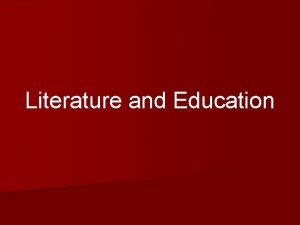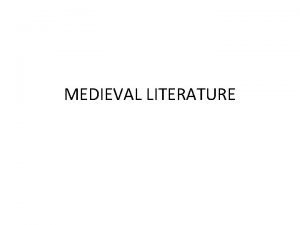The language of literature The language of literature










- Slides: 10

The language of literature

The language of literature differs from other kinds of language in many ways: 1. First there are different genres of literature, namely essays, novels, short stories, drama, and poetry. 2. The content of most literary genres is usually different from the more factual content of scientific, journalistic texts or the texts that deal with the various branches of business, for example.

In the restricted sense, literature is more concerned with human life: socio-economic, and emotional, than with facts and figures, and realistic situations and aspects.

3. The language employed in literature is bound to differ from ordinary, scientific, journalistic, business or other brands of language. Not only this, but the form of some genres, such as poetry is often as important as, if not more important than, the content. Music, for example, is one of the important elements in this genre. Figures of speech such as simile, metaphor, puns, irony, etc. abound in the language of literature, especially poetry and drama. So do proverbs, idioms, clichés and historical and other references.

Consequently , we find a great deal of connotation (i. e. non-literal, mostly emotive, meaning) rather than denotation (i. e. literal meaning) in the language of literature. For instance, ﺃﺒﻴﺾ is denotatively used in ﻗﻤﻴﺺ ﺃﺒﻴﺾ 'a white shirt' but connotatively in ﺛﻮﺭﺓ ﺑﻴﻀﺎﺀ ' a peaceful, bloodless revolution'. In the following example, the translator has used the term ‘lady’ rather than ‘woman’ since ‘lady’ has overtones of respect. ﻣﻼﻳﻴﻦ ﺍﻟﻨﺴﺎﺀ ﻳﺎ ﺃﻨﺜﺎﻱ ﻣﻦ ﺑﻴﻦ. . . آﻪ ﻳﺎ ﺑﻴﺮﻭﺕ Ah Beirut…. my lady amongst millions of women . •

4. The traditional grammatical structure of sentences is often either deliberately violated, or at least not closely observed, which makes it difficult for the reader or listener to decipher or understand the language

5. The question of the relationship between language and culture looms very big here, more than in any other types of language. Literature is a mirror of the community that speaks the language of that literature. In fact we can, study and learn a great deal about the culture of a certain community by examining its literature.

6. The language of literature is usually full of • cultural references: references to mythology, religion, beliefs, customs, historical events , social aspects of the life of people, conflicts, important landmarks, etc. This characteristic of most literary genres often makes it very difficult to fully understand or appreciate a certain text, let alone translate it into the language of another community.

This difficulty becomes more obvious and more resistant to translation if the two cultures are not historically or spatially related, such as the British and Arabic cultures. 7. Finally, we have to mention the style used in the different genres. In fact it may vary in one and the same literary genre, such as drama. This may depend on the speakers: it can be vulgar, intimate, neutral, semi-formal or very formal depending on who is addressing whom.

This is often quite common also in novels and short stories which necessarily use a lot of dialogue to add to the vitality and vividness of the text.



















